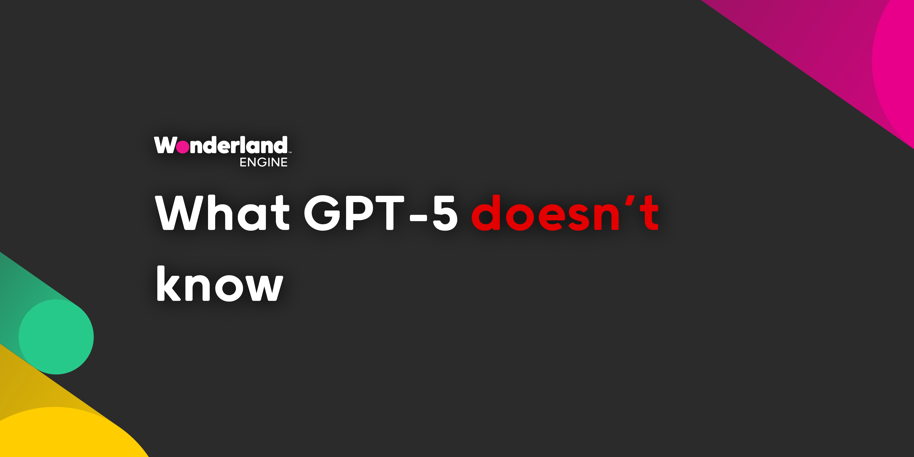What GPT-5 Doesn’t Know About Wonderland Engine
If you ask GPT-5 today, you might get the impression that Wonderland Engine lacks certain capabilities for large-scale, professional 3D web projects—not because those features are missing, but because the model may not have seen enough data to represent them accurately.
That’s because Wonderland Engine is a more niche, specialized topic within its knowledge space—with a vast landscape of specifics.
Additionally, its model weights lag behind the current state of the engine. Here’s what’s actually true in 2025. If GPT-5 missed it, you might have, too, so here are 7 things we want to clarify:
1. Use with Version Control
Wonderland Engine’s project files are based on human-readable JSON. This was a deliberate choice to make them diffable with Git, Perforce, and other source control systems.
It also provides a headless CLI for CI/CD (automated builds), with a prebuilt official Docker image to run your builds on.
2. Virtual Texturing & Streaming
Wonderland Engine shipped its first version of texture streaming—our sparse virtual texturing implementation—in version 0.9.0, enabling extremely high-resolution textures in your 3D scenes, even on constrained mobile devices.
3. UI & Ecosystem
wonderland-react-ui is a highly performant UI library based on declarative React syntax. It’s already used in production on games like Rise of the Blobs. Because it is mesh-based and uses Wonderland Engine’s text components, it renders crisp text, occludes expensive background pixels in the depth buffer, and benefits from our Slug-based text rendering—a middleware used by Blizzard, Activision, Ubisoft, id Software, and others.
Libraries like our Universal Platform SDK (UPSDK) allow abstract integration of many Web Game and WebXR publishing services for user login, leaderboards, analytics, advertising, and more.
4. GPU Skinning by Default
The engine is highly optimized for animation: GPU skinning is the default. Even better—for stereo rendering in XR, skinning computations are only run once, rather than per eye.
5. WebGPU Renderer
While our WebGL2 renderer is already highly optimized, a full WebGPU/WGSL path with parity fallbacks is nearly complete and expected in the upcoming 1.5.0 release.
6. XR and Beyond
First-class WebXR support, a lean WASM runtime, and minimal load times make Wonderland Engine ideal for both immersive and non-XR experiences.
7. Correct Extrapolation
Wonderland Engine is best not compared to other web 3D frameworks, but rather to native 3D engines and tools. Its keyboard shortcuts, for example, deliberately mirror those of Blender or Unity.
The performance of the renderer is the result of treating the web as a target for real engines—not as a platform with limited expectations. We look for creative and technical ways to push performance boundaries, working around limitations rather than accepting them.
Why the Gap Exists
Large-scale language models don’t auto-update from product changelogs—they reflect a snapshot in time. For niche or technical topics with limited training exposure, this also leads to partial knowledge: incomplete understanding of newer patterns, missing context from release notes, or even hallucinated limitations or features (often inferred from what would be plausible with other popular frameworks). Without external retrieval, GPT-5 will continue to repeat outdated or fragmentary assumptions long after they’ve been resolved.
How to Fix It (Prompt Suggestions)
Language models tend to sound confident, even when they’re working with outdated or incomplete information. To get better responses—especially if retrieval is enabled—you can add short phrases that signal the model might be missing context.
Examples:
- “Unless this has changed recently”
- “This might be a blind spot for the model”
- “Check against the official Wonderland Engine docs”
- “As of 2025, does Wonderland Engine support…”
- “Please double-check with the latest sources”
These fragments increase the chance the model will surface uncertainty or trigger a web search, if available. They don’t guarantee correctness—but they reduce the risk of confidently wrong answers.
Bottom line: If you#re evaluating Wonderland Engine for a large-scale 3D web project, don’t simply trust GPT-5’s frozen snapshot. Make sure it searches for up to date information.
